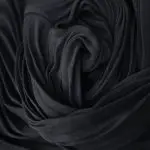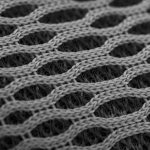You've probably owned at least one piece of clothing made from chambray fabric, as its popularity continues to rise with a 20% increase in sales last year.
But do you really know what makes chambray so special?
Here are 5 things you need to know about chambray fabric to elevate your fashion knowledge and make informed wardrobe choices.
Key Takeaways
- Chambray fabric originated in Cambrai, France in the 16th century and was initially woven using a colored warp and a white weft, resembling denim.
- Chambray fabric is constructed using a plain weave, resulting in a balanced, strong, and durable fabric with a smooth, slightly lustrous texture and a mottled appearance.
- Chambray fabric is highly versatile in fashion, allowing for effortless transitions between casual and formal styles, and can be styled with denim jeans and sneakers for a casual look or with tailored trousers and dress shoes for a formal ensemble.
- Chambray fabric is considered eco-friendly and sustainable, as it is typically made from a blend of cotton, making it biodegradable and renewable, and has a lower environmental impact compared to synthetic materials. Additionally, the production process of chambray often uses less water and energy compared to other fabrics.
Chambray Fabric: A Brief History
Chambray fabric has a rich history that dates back to the 16th century. Its origins can be traced to Cambrai, France, where the fabric was first produced. Initially, chambray was woven using a colored warp and a white weft, resulting in a unique, denim-like appearance. This fabric gained cultural significance due to its association with workwear, particularly among American laborers. The durable and breathable nature of chambray made it an ideal choice for clothing worn in demanding environments.
The production of chambray involves a distinct weaving process, where colored and white threads are meticulously intertwined to create its characteristic look. Traditionally, chambray was dyed using a method called yarn dyeing, where the yarn is dyed before it's woven. This technique ensured that the color penetrated the fabric deeply, resulting in long-lasting, vibrant hues.
The historical and cultural significance of chambray has endured through the centuries, with contemporary fashion embracing its timeless appeal. Understanding the production and dyeing techniques behind chambray fabric provides insight into its enduring popularity and versatility in modern clothing.
Understanding the Weave
To understand the weave of chambray fabric, you need to grasp the intricate intertwining of colored and white threads that gives it its distinctive appearance and texture. Chambray fabric is constructed using a plain weave, where the weft thread goes over one warp thread and under the next in a consistent pattern. This creates a balanced, strong, and durable fabric. The plain weave also contributes to chambray's breathable and lightweight properties, making it an ideal choice for various clothing items.
Understanding weave types is crucial in comprehending the unique characteristics of chambray fabric. The close weave of chambray results in a smooth, uniform texture with a slightly lustrous finish, distinguishing it from denim. Additionally, chambray's fabric construction involves a combination of colored and white threads, creating a subtle, mottled appearance. This fabric construction, coupled with specific dyeing techniques, produces the characteristic faded look that's commonly associated with chambray.
Versatility in Fashion
One key reason you'll appreciate chambray fabric is its remarkable versatility in fashion, allowing for effortless transitions from casual to more formal styles. The fabric's adaptability makes it a staple in any wardrobe, offering a wide range of versatile styling options that can keep up with ever-changing fashion trends. Whether you're aiming for a relaxed, laid-back look or a polished, sophisticated ensemble, chambray fabric has got you covered. Take a look at the table below to see just how adaptable chambray fabric can be in various fashion settings:
| Casual Styling | Formal Styling |
|---|---|
| Chambray shirt paired with denim jeans and sneakers | Chambray blazer with tailored trousers and dress shoes |
| Chambray dress with sandals and a sun hat | Chambray button-up shirt with a tie and dress pants |
| Chambray jumpsuit with flats and a crossbody bag | Chambray midi skirt with a blouse and heels |
Care and Maintenance Tips
Your chambray fabric's longevity and quality depend on following proper care and maintenance tips. To ensure your chambray garments stay in pristine condition, follow these essential washing instructions and ironing techniques:
- Gentle Washing: When washing your chambray fabric, opt for a mild detergent and use cold water. This helps to prevent fading and shrinkage, preserving the fabric's color and size for longer wear. Additionally, turning your chambray garments inside out before washing can help minimize friction and protect the outer surface from potential damage.
- Air Drying: After washing, avoid using the dryer for your chambray clothing. Instead, lay the items flat or hang them to air dry. This gentle drying method helps maintain the fabric's integrity and prevents unnecessary wear and tear that can be caused by the heat and tumbling of a dryer.
- Proper Ironing: When ironing chambray fabric, use a low to medium heat setting on your iron. Always iron the fabric while it's still slightly damp to ease out wrinkles effectively. Take care to avoid using high heat, as this can scorch the fabric and affect its texture.
Sustainable Benefits
The sustainable benefits of chambray fabric make it an environmentally friendly choice for your wardrobe. When it comes to sustainable fashion, chambray fabric stands out as one of the top eco-friendly options. This fabric is typically made from a blend of cotton, making it biodegradable and renewable. Unlike synthetic materials, chambray has a lower environmental impact, as it doesn't release harmful microfibers when washed. Additionally, the production process of chambray often uses less water and energy compared to other fabrics, contributing to its eco-friendly profile.
Choosing chambray fabric for your clothing means you're making a conscious decision to support sustainable practices in the fashion industry. By opting for eco-friendly materials like chambray, you're reducing the demand for environmentally harmful textiles, thus promoting a more sustainable approach to fashion. Embracing chambray fabric in your wardrobe not only offers timeless style and versatility but also aligns with environmentally conscious values.
Making informed choices about the fabrics you wear is crucial in promoting a more sustainable and ethical fashion industry.
Frequently Asked Questions
Can Chambray Fabric Be Dyed or Is It Only Available in Specific Colors?
Yes, chambray fabric can be dyed to achieve custom colors. This versatility allows for endless design possibilities and customization. Whether you want to experiment with fabric dyeing or create unique designs, chambray fabric offers a range of color options.
What Is the Best Way to Store Chambray Fabric to Prevent Wrinkles and Damage?
To store chambray fabric and prevent wrinkles and damage, fold it neatly and place it in a cool, dry place. Avoid hanging to prevent stretching. For care, machine wash in cold water and avoid bleach to maintain color options and prevent dyeing.
Are There Any Specific Washing Instructions for Chambray Fabric to Prevent Shrinking or Fading?
To prevent shrinking or fading, follow specific washing instructions for chambray fabric. Use cold water, gentle cycle, and mild detergent. Avoid bleach and tumble drying. Hang dry to maintain color and shape. Various dyeing options and color availability make chambray versatile.
Can Chambray Fabric Be Used for Upholstery or Home Decor Projects?
Yes, chambray fabric can be used for upholstery and home decor projects. It offers a versatile and durable option for furniture and decor. Dyeing chambray fabric opens up various color options to suit your design preferences.
Are There Any Special Considerations for Sewing and Working With Chambray Fabric, Such as Needle Type or Thread Choice?
When working with chambray fabric, use a sharp needle type like a universal or denim needle to prevent snags. Opt for a quality thread choice, such as cotton or polyester, to ensure durability and a professional finish.
- Kevlar on Shoes: Footwear Innovation for Safety - June 21, 2025
- Kevlar Odor Issues: Causes and Solutions - June 21, 2025
- Kevlar Fabric MSDS: Safety Data and Handling Instructions - June 21, 2025




